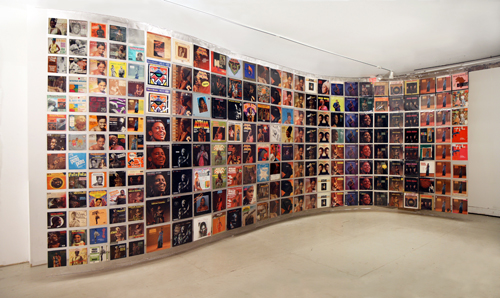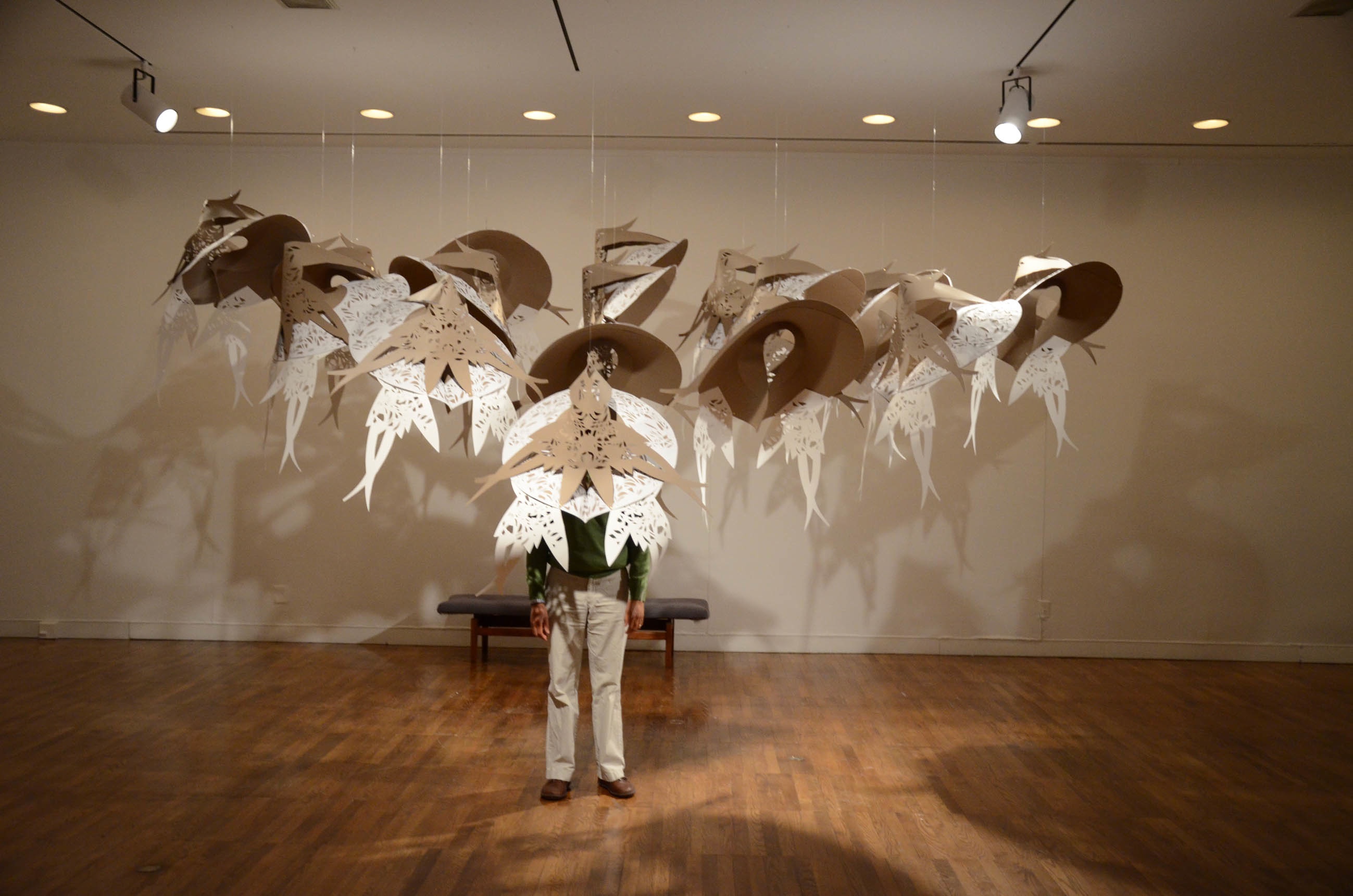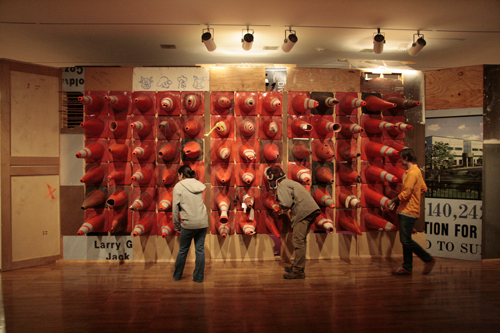Tumelo Mosaka is a South African curator based in Princeton, NJ. He has received a B.A. (1993) in Fine Arts from the University of Witwatersrand in Johannesburg, South Africa and an M.A. (2000) from the Center for Curatorial Studies at Bard College in New York.
Mosaka currently serves as the Curator of Contemporary Art at the Krannert Art Museum (KAM) in Champaign, IL; he pursues curatorial projects independently as well. During his tenure at KAM, he has curated the following exhibitions: On Screen: Global Intimacy (2009), Baggage Allowance (2010), The Bikeriders: Danny Lyon (2010), Lida Abdul (2010), OPENSTUDIO (2011), The Kangarok Epic (2011), iona rozeal brown (2011), and Makeba! (2011).
Prior to joining KAM, Mosaka was Associate Curator of Exhibitions at the Brooklyn Museum, where he organized the exhibitions Infinite Islands: Contemporary Caribbean Art (2007) and Passing/Posing: Kehinde Wiley (2004) and co-curated Open House: Working in Brooklyn (2004). In addition, he organized the presentation of Alexis Rockman’s monumental mural Manifest Destiny (2004), Petah Coyne (2008), and co-organized @ Murakami (2008). Previously, he worked for the Spoleto Festival USA in Charleston, South Carolina, where he co-curated the exhibition Evoking History (2002). Mosaka has organized several national and international exhibitions for other institutions such as the National Center for Afro-American Arts (2004) and the St. Louis Contemporary Art Museum (2003).
It is a true pleasure to present to you Tumelo Mosaka, a low-key force who is making a long-term investment in art by setting his priorities, wants and ambitions straight.
Georgia Kotretsos: Right after Sandy hit New Jersey, you were reading Nadine Gordimer‘s “No time like the present” and Adekeye Adebajo‘s “The curse of Berlin: Africa after the cold war.” Nearly 18 year after the abolition of apartheid, how does the new democracy seem to you now, from the perspective of living in the United States, and how has that perhaps affected its art world?
Tumelo Mosaka: Yes, how ironic to be reading “No time like the present” when for a moment, it seemed like there was no tomorrow. The storm Sandy came through and changed the way we think about the climate today and most of all exposed our vulnerability. This was indeed a wake up call that no man or country is an island and immune from mother nature’s anger. The devastation was inconceivable; [even] with all the advance warning, it was just not something we could imagine happening.
Enough about Sandy; looking back at 18 years of democracy in South Africa leaves me conflicted about the changes taking place. True enough, South African democracy is still young, but that’s no excuse for not delivering the basic resources like shelter, water and security. Instead, what has become apparent is that the richer have gotten richer and the poor have gotten even poorer. Is this the democracy we fought so hard for? This is a very simplified response to a very complex situation. Of course there are challenges as well as triumphs, but when you look at the overall picture, it’s unfortunately not a pretty picture as many South Africans continue to live below the bread line.
Art in South Africa has played a major role in reflecting and critiquing the social changes taking place. During the struggle days, art was considered a cultural weapon. I still believe it has the potential to be effective. For instance, President Jacob Zuma recently tried to censor certain works that have been critical of his stance as a leader. Since the new democracy, South African artists have received international attention – with several showing consistently abroad, but for the majority, the local context remains their field, which is still largely segregated. This of course is the result of apartheid’s legacy. I think it will take education, together with socio-economic growth, to level the playing field. For the majority of South Africans, issues of bread and butter are still a priority. The government seems not to take art seriously. The museums in the country are struggling to maintain and grow their collections. The collector base is still very small, and so artists are looking for opportunities elsewhere and as a result important works by South African artists end up in foreign collections.
What has changed, is that there is more access to information and artists can show where they wish. Local institutions have become more sensitive to showing a diverse range of works by artists from different races. Freedom of mobility and expression are endorsed by the constitution; however, one cannot ignore the censorship, homophobia and violence against women that continue to mar the idea of the Rainbow Nation! Change comes at a prize, and democracy is only an idea that we aspire towards. We still have a long way to go.
GK: The Stevenson Gallery in Cape Town and Johannesburg is currently on its third exhibition focusing on Trades Routes Over Time in an effort to revive and celebrate the 15th anniversary of a pivotal moment of South Africa’s contemporary art history. You were part of the second “Trade Routes: History and Geography” Johannesburg Biennial in 1997. What was that like for you then? Did you ever stop to consider the impact it might have had or still has?
TM: Well, there have been many attempts to revive the third Biennale and so far, with very little success. I think the lack of political will from government is partly to blame. Let’s not forget that Biennales also have a political agenda that’s geared towards attracting international attention. However, during the second Biennale, the government decided to close the show three weeks earlier claiming that such an action would save money. The issue was more that the government was recanting on its promise after having made a commitment. I guess when the stage lights go off after a week of celebration, reality kicked in.
This was an important moment as many of us were beginning to learn about what other artists from around the world were making and discussing. It was an important event for us to step outside our skin and to learn about other things taking place continents away that resonated with our struggle. It’s hard to measure impact but [the fact that] we are still discussing it today, says a lot about its influence. Since I’ve not had the chance to see the show at Stevenson Gallery, I can’t really comment. I think rather than reviving an old idea, it could be more interesting to move the theme of the show forward. I’m not really interested in the discussions about the Biennale, but am curious about further exploring the notion of Trade Roots, especially in the 21st Century!
GK: You’ve been in the States for over ten years, always affiliated with institutions in curatorial positions. Most recently you’ve also found time to pursue projects independently. What are the benefits and challenges of working for the Krannert Art Museum as well as independently?
TM: I worked as an independent curator before coming to the US and found freedom to be most rewarding and difficult thing to manage. Being your own boss until your projects get co-opted into the institution requires both discipline and courage. I was lucky that most of my projects were invitational. Working at the Krannert, a mid-sized museum at the University of Illinois with both a collection and active faculty and student involvement, has allowed me to collaborate with a wide range of individuals within the university community, including not only students and faculty members from various departments, but alumni, community members, and visiting scholars.
This experience has enabled me to pursue several key curatorial interests, including staging exhibitions of international artists; focusing on issues of race, ethnicity, and gender as a way of interrogating identity construction; and transforming the museum into an active zone of engagement. Exhibitions such as Blind Field (2013), MAKEBA! (2012) and On-Screen: Global Intimacy (2009), demonstrate the international scope of projects I have undertaken. These projects have also focused on underrepresented regions of artistic production—Brazil, South Africa, and Cuba among them—and called into question facile distinctions between tradition and modernity, empowerment and subjugation.
Of course the challenges are many, the most crucial one being fundraising. Working within the University has been great because of the resources available to support such initiatives, however, it’s not always enough. The Krannert has been a great place for me to advance my practice and to consider working across different disciplines. For instance, I developed OPENSTUDIO, a public program and artist residency intended to forge interdisciplinary learning and cultural exchange between students, faculty, and the community of the University of Illinois, Champaign-Urbana. Projects included performance, mural drawing, experimental dance and environmental explorations. [It’s about] transforming the museum into an active space of production rather than the familiar passive and contemplative viewing. I’ve been thinking about ways of broadening the museum’s definition with the understanding that not all museums need to be this interactive. Being at a research university has provided the context for such experimentation and research, which I hope to continue.

From the exhibition On-Screen: Global Intimacy, 2011. Installation image. Photo by Kathryn Koca Polite.
GK: What draws you to emerging artists’ work?
TM: I don’t think I do that intentionally, however, I’m drawn to working with artists who are less known because of the flexibility and uncertainty about their works. I’m interested in this moment of fragility and unpredictability. This is because I also begin from the point of uncertainty with the hope of collaborating with the artist in a process of discovery.
I’m always interacting with artists who have been overlooked by the art world. I’m always searching for what I can’t find and so the journey becomes crucial in expressing those vulnerabilities, and at times, convictions about personhood. I guess I’m also interested in developing primary scholarship around the works of artists whose ideas challenge my thinking. Finally, I don’t see many of these artists as emerging, they are artists whose voices have not been heard for various reasons.
*This conversation will be continued on the Art21 Blog next Friday, when Tumelo Mosaka will discuss his upcoming co-curatorial project (with Irene V. Small) “Blind Field,” which focuses on twenty Brazilian artists. “Blind Field” will be presented at the Krannert Museum and later, the Broad Museum (June 13).








Pingback: Inside the Artist’s Studio | Tumelo Mosaka (Part 2) | Art21 Blog
Pingback: The Art of Transformation Is Here! | The Art of Transformation Is Here! | Social Dashboard
Pingback: The Art of Transformation Is Here! | What Stupid Does
Pingback: The Art of Transformation Is Here! | Pinoria News